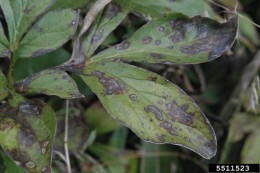I love peonies! I’m lucky to have a neighbor down the street with an amazing display every spring.
Peonies do need some attention, though, including cutting them back. One reason to cut them back is to remove leaves infected with “peony measles.” By removing infecting the leaves from the site you can disrupt the life cycle. The fungus survives year-to-year in infected leaves, so removing them reduces infection risk next year.
(Photo by Ward Upham)
Here are some tips from Ward Upham from the Kansas Horticulture News:
Cut peony foliage back to the ground if this hasn’t been done already. Compost or discard foliage. Fertilize peonies twice a year — in the spring shortly before new growth appears and then again in the fall after the plants have been cut back. A total of 1.5 to 2 ounces (3 to 4 tablespoons) of a 1-1-1 fertilizer such as a 10-10-10 or 13-13-13 per plant per application should be used. This amounts to 3 to 4 ounces of fertilizer per year. If a soil test reveals adequate levels of phosphorus and potassium, use a lawn fertilizer such as a 29-5-4, 27-3-3 or something similar, but cut the rate to 1/3 of the above rate. In other words apply ½ to 3/4 ounce (1 to 1.5 tablespoons) per plant. The lawn fertilizer should not be a “weed and feed.”
Never apply fertilizer directly on the center of the peony as the buds (eyes) may be damaged. Rather, place the fertilizer in a band from 8 to 18 inches from the center of the plant. Water the fertilizer in so the plant can take it up.
Winter protection of herbaceous peonies is only necessary the first winter after planting to prevent alternate freezing and thawing from lifting plants out of the soil. A couple of inches of mulch should be sufficient. Any organic material that does not mat down will work and should be applied after the ground freezes. Avoid using leaves that will mat together. Remove the covering before growth begins in the spring.
The less common tree peonies have woody stems like deciduous shrubs and should not be cut back to the ground or pruned in the fall. Collect the shed leaves and place in the compost pile this fall. Though tree peonies are hardy to Zone 4, they do benefit from a light mulching over winter. Also, it is recommended that tree peonies be fertilized during November to get the plants off to a good start next spring. It is best to take a soil test to see what nutrients are needed. If the soil needs phosphorus and potassium, use a complete fertilizer (such as 10-10-10, 9-9-6, etc.) at the rate of 2.5 pounds per 100 square feet. This would equal 1 rounded teaspoon per square foot.
If phosphorus and potassium are not needed, blood meal makes an excellent fertilizer. Apply at the rate of 2 pounds per 100 square feet or 1 teaspoon per square foot. Turf fertilizers such as a 27-3-3 or 30-3-3 also can be used but at the rate of to 1 pound per 100 square feet or 1 teaspoon per 2 square feet.

